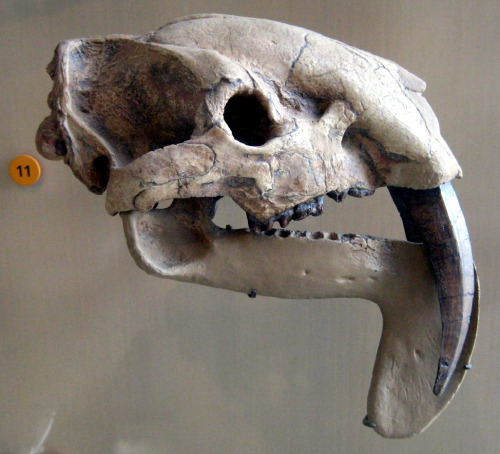Thylacosmilus - marsupial sabertoothSkull on display at the American Museum of Natural History.Recon
Thylacosmilus - marsupial sabertoothSkull on display at the American Museum of Natural History.Reconstruction by Mauricio Antón. When: Late Miocene to Late Pliocene (~10 million to 3 million years ago)Where: South America, most fossils are from Argentina, but it was fairly widespread. What: Thylacosmilus at first glance looks much like the famous Smilodon (sabertooth tiger). But a closer look starts to reveal many significant differences, such as the extremely large flanges on its lower jaw, which protect the large canines, and the lack of any teeth anterior to these massive teeth. This animal is very far removed from Smilodon, it is not even a placental mammal. It is a metatherian (marsupials are the living metatherians) more closely related to kangaroos, koalas, wombats, etc than to the saber-toothed tiger. The similarity between Thylacosmilus and Smilodon is an excellent example of convergent evolution - two distantly relating forms converging upon a simular morphology and life habitat. There are an three other examples of mammals that have developed saber-teeth- in fact most of the last 65 million years had some large cat-like saber-toothed mammal present, the modern biota is the outlier. Thylacosmilus went extinct roughly 3 million years ago, closely coinciding with the formation of the land bridge linking the Americas. Animals from North America emigrated south and those from South America journeyed north; this fauna exchange is referred to as the Great American Interchange. It is at this time we start to find Smilodon fossils in South America. It is thought that the arrival of this relatively larger predator (the largest Smilodon was twice the size of the largest Thylacosmilus) may have been what drove the only known marsupial saber-toothed form to extinction. -- source link
Tumblr Blog : dailyfossil.tumblr.com
#metatherian#thylacosmilus#miocene#plicoene#south america#sabertooth#fossils#paleontology#vertebrate#marsupial#evolution#geology#biology#fossil

